| Availability: | |
|---|---|
| Quantity: | |
1.Introduction:
The DT series copper cable lug is a high-quality electrical connector designed for secure and efficient termination of copper conductors. It features an acid-washed surface treatment, which ensures optimal conductivity and corrosion resistance. This lug is engineered to provide a reliable, permanent connection in various electrical applications, from power distribution to industrial machinery.
The DT series copper crimp lug (also known as a copper terminal or connector) is a critical component for joining copper cables to electrical equipment. Its design includes a cylindrical barrel for crimping onto the cable conductor and a flat tongue with a pre-punched hole for bolting to terminals. The acid-washed surface treatment enhances its performance by removing oxides and impurities, resulting in a clean, matte-finish surface ready for crimping. This lug combines high electrical conductivity with mechanical durability, making it ideal for demanding environments.
2. Drawings:
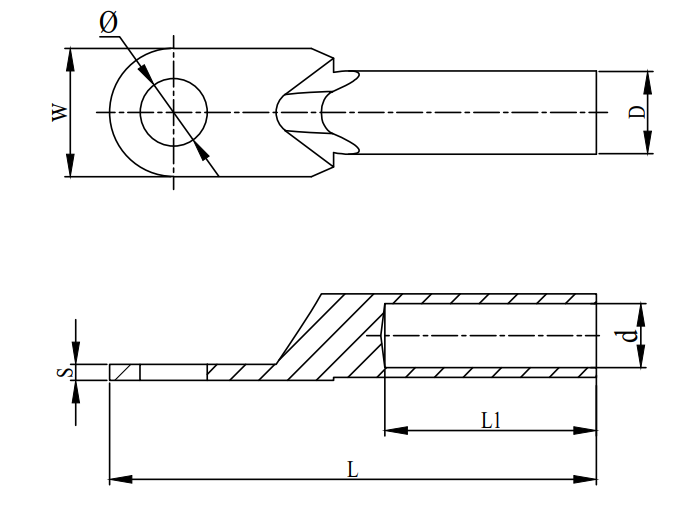
3.Specifications:
Type | Dimension(mm) | |||||
φ | D | d | L | L1 | W | |
DT-10 | 8.5 | 9 | 5.2 | 63 | 32 | 16 |
DT-16 | 8.5 | 10 | 6.2 | 66.2 | 33.4 | 16 |
DT-25 | 8.5 | 11 | 7 | 72 | 33.4 | 18 |
DT-35 | 10.5 | 12 | 8.2 | 75.8 | 39 | 20 |
DT-50 | 10.5 | 14 | 9.8 | 86.2 | 42 | 23 |
DT-70 | 12.5 | 16 | 11.4 | 93 | 45 | 26 |
DT-95 | 12.5 | 18 | 13.8 | 103 | 48 | 28 |
DT-120 | 14.5 | 20 | 14.8 | 110.4 | 50.2 | 30 |
DT-150 | 14.5 | 22 | 17.2 | 117.2 | 52.2 | 34 |
DT-185 | 16.5 | 25 | 19 | 124 | 57.4 | 37 |
DT-240 | 16.5 | 27 | 20.8 | 135 | 63 | 40 |
DT-300 | 18 | 31 | 23 | 150 | 67 | 50 |
DT-400 | 21 | 34 | 26.5 | 158 | 68 | 50 |
DT-500 | 21 | 38 | 29 | 166 | 74 | 54.2 |
DT-630 | 21 | 45 | 34.2 | 203 | 78.6 | 59.8 |
4.Material
Primary Material: High-purity electrolytic copper (typically meeting standards like T2 or TU1), known for excellent electrical conductivity (≥98% IACS).
Surface Treatment: Acid washing using a phosphoric acid-based solution to remove oxides, contaminants, and minor imperfections. This process leaves a uniform matte finish while improving surface adhesion for crimping.
5. Production Process
Material Selection: High-conductivity copper rods or strips are selected and cut to size.
Forming: The copper wire terminal shape is cold-forged or stamped to form the barrel and tongue structure.
Hole Punching: A precision hole is punched in the tongue for bolt/screw fastening.
Acid Washing: Cable Terminal Lugs are immersed in a phosphoric acid solution to clean the surface, remove oxides, and etch the material slightly for improved crimp retention.
Rinsing and Drying: Thorough rinsing removes acid residues, followed by drying to prevent oxidation.
Quality Inspection: Each crimp terminal is checked for dimensional accuracy, surface quality, and conductivity.
Marking and Packaging: Size and model markings (e.g., "DT", "185") are stamped, and lugs are packaged for shipment.
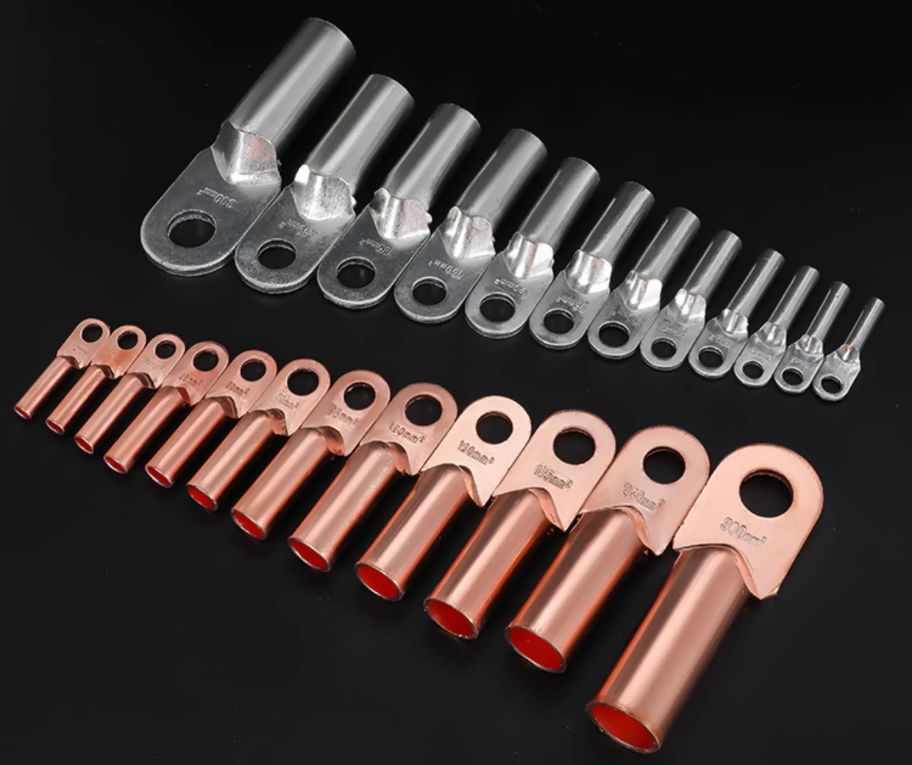
6. Features
High Conductivity: Ensures minimal energy loss and efficient current transfer.
Superior Crimp Performance: The acid-washed surface provides a clean, oxide-free interface for reliable crimping and reduced electrical resistance.
Corrosion Resistance: Acid washing passivates the surface, enhancing resistance to oxidation and environmental degradation.
Mechanical Strength: Robust construction withstands vibration, thermal cycling, and mechanical stress.
Versatile Sizing: Available in multiple sizes (e.g., DT185 for 185 mm² cables) to accommodate various conductor cross-sections.
Compliance: This Electrical Connector meets international standards (e.g., IEC 61238, UL 486) for safety and performance.
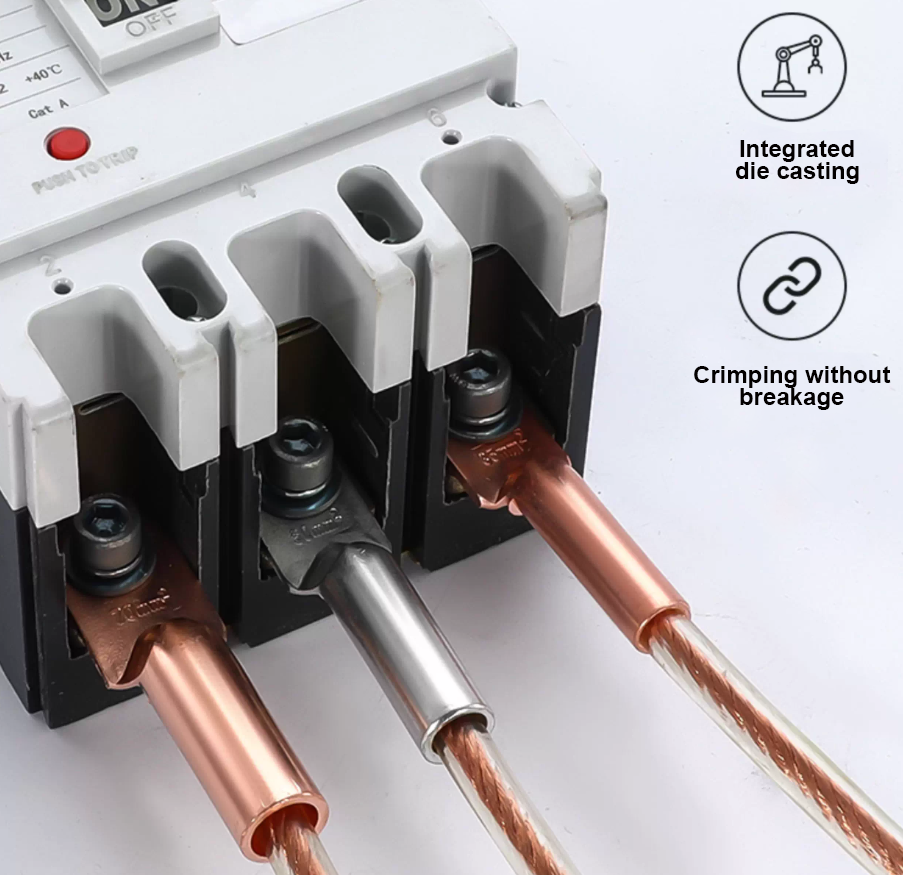
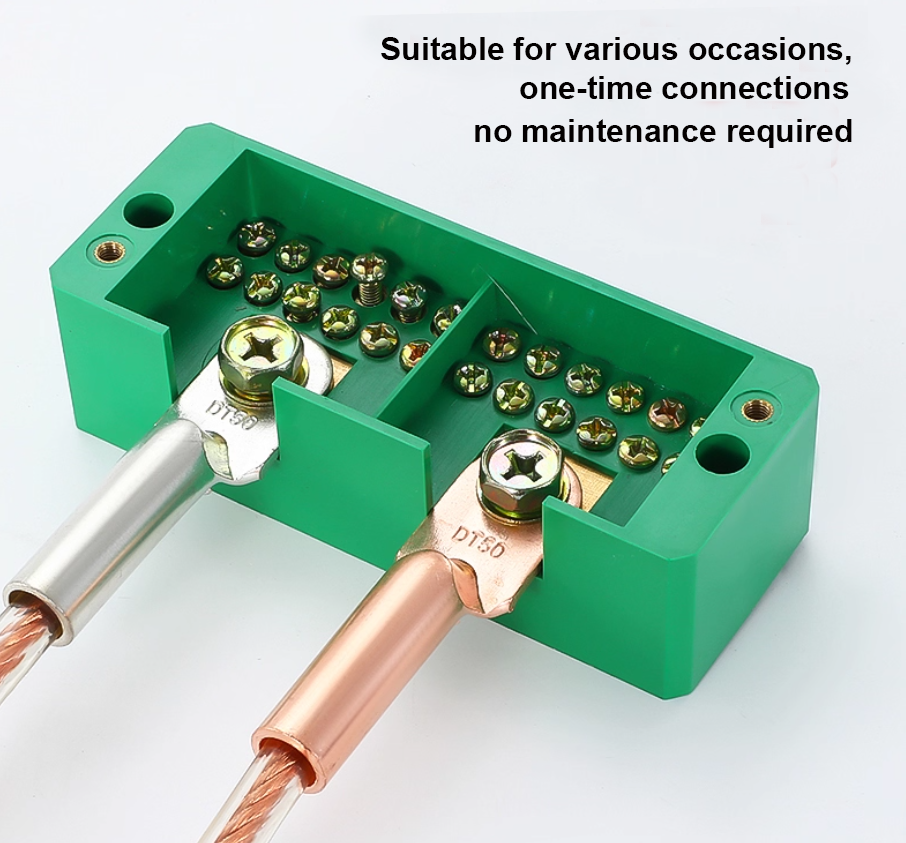
7. Applications
Power Distribution: Connecting cables to circuit breakers, switchgear, and distribution boards in substations.
Industrial Equipment: Terminations for motors, transformers, generators, and control panels.
Renewable Energy Systems: Interconnecting cables in solar farms, wind turbines, and battery storage (e.g., UPS, electric vehicles).
Transportation Infrastructure: Railway electrification, airport ground power systems, and EV charging stations.
Telecommunications and Data Centers: Grounding and power connections in critical infrastructure.
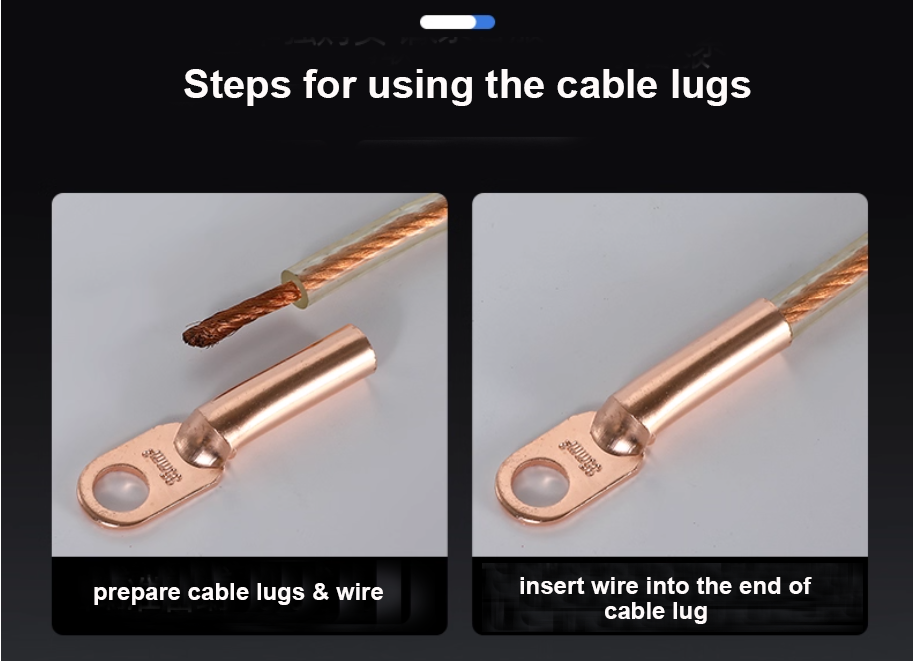
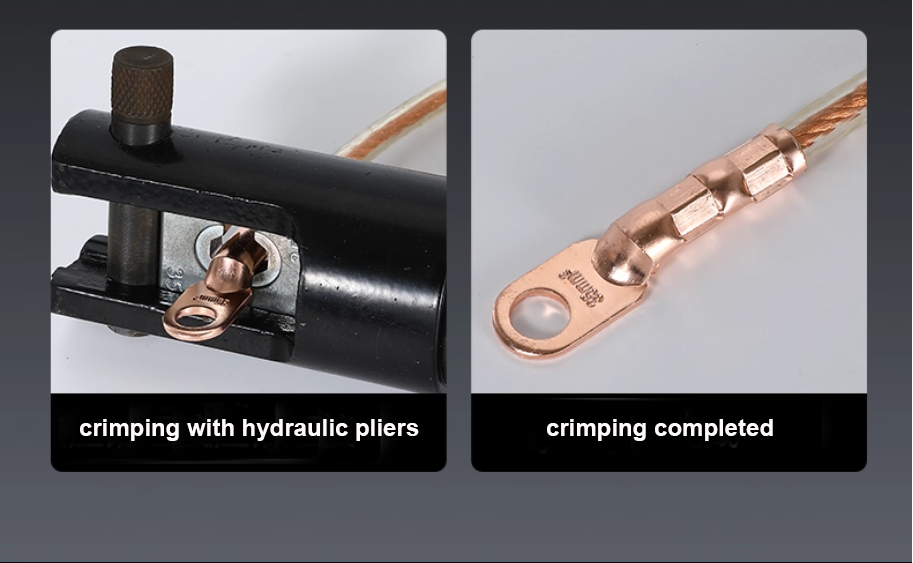

1.Introduction:
The DT series copper cable lug is a high-quality electrical connector designed for secure and efficient termination of copper conductors. It features an acid-washed surface treatment, which ensures optimal conductivity and corrosion resistance. This lug is engineered to provide a reliable, permanent connection in various electrical applications, from power distribution to industrial machinery.
The DT series copper crimp lug (also known as a copper terminal or connector) is a critical component for joining copper cables to electrical equipment. Its design includes a cylindrical barrel for crimping onto the cable conductor and a flat tongue with a pre-punched hole for bolting to terminals. The acid-washed surface treatment enhances its performance by removing oxides and impurities, resulting in a clean, matte-finish surface ready for crimping. This lug combines high electrical conductivity with mechanical durability, making it ideal for demanding environments.
2. Drawings:

3.Specifications:
Type | Dimension(mm) | |||||
φ | D | d | L | L1 | W | |
DT-10 | 8.5 | 9 | 5.2 | 63 | 32 | 16 |
DT-16 | 8.5 | 10 | 6.2 | 66.2 | 33.4 | 16 |
DT-25 | 8.5 | 11 | 7 | 72 | 33.4 | 18 |
DT-35 | 10.5 | 12 | 8.2 | 75.8 | 39 | 20 |
DT-50 | 10.5 | 14 | 9.8 | 86.2 | 42 | 23 |
DT-70 | 12.5 | 16 | 11.4 | 93 | 45 | 26 |
DT-95 | 12.5 | 18 | 13.8 | 103 | 48 | 28 |
DT-120 | 14.5 | 20 | 14.8 | 110.4 | 50.2 | 30 |
DT-150 | 14.5 | 22 | 17.2 | 117.2 | 52.2 | 34 |
DT-185 | 16.5 | 25 | 19 | 124 | 57.4 | 37 |
DT-240 | 16.5 | 27 | 20.8 | 135 | 63 | 40 |
DT-300 | 18 | 31 | 23 | 150 | 67 | 50 |
DT-400 | 21 | 34 | 26.5 | 158 | 68 | 50 |
DT-500 | 21 | 38 | 29 | 166 | 74 | 54.2 |
DT-630 | 21 | 45 | 34.2 | 203 | 78.6 | 59.8 |
4.Material
Primary Material: High-purity electrolytic copper (typically meeting standards like T2 or TU1), known for excellent electrical conductivity (≥98% IACS).
Surface Treatment: Acid washing using a phosphoric acid-based solution to remove oxides, contaminants, and minor imperfections. This process leaves a uniform matte finish while improving surface adhesion for crimping.
5. Production Process
Material Selection: High-conductivity copper rods or strips are selected and cut to size.
Forming: The copper wire terminal shape is cold-forged or stamped to form the barrel and tongue structure.
Hole Punching: A precision hole is punched in the tongue for bolt/screw fastening.
Acid Washing: Cable Terminal Lugs are immersed in a phosphoric acid solution to clean the surface, remove oxides, and etch the material slightly for improved crimp retention.
Rinsing and Drying: Thorough rinsing removes acid residues, followed by drying to prevent oxidation.
Quality Inspection: Each crimp terminal is checked for dimensional accuracy, surface quality, and conductivity.
Marking and Packaging: Size and model markings (e.g., "DT", "185") are stamped, and lugs are packaged for shipment.

6. Features
High Conductivity: Ensures minimal energy loss and efficient current transfer.
Superior Crimp Performance: The acid-washed surface provides a clean, oxide-free interface for reliable crimping and reduced electrical resistance.
Corrosion Resistance: Acid washing passivates the surface, enhancing resistance to oxidation and environmental degradation.
Mechanical Strength: Robust construction withstands vibration, thermal cycling, and mechanical stress.
Versatile Sizing: Available in multiple sizes (e.g., DT185 for 185 mm² cables) to accommodate various conductor cross-sections.
Compliance: This Electrical Connector meets international standards (e.g., IEC 61238, UL 486) for safety and performance.


7. Applications
Power Distribution: Connecting cables to circuit breakers, switchgear, and distribution boards in substations.
Industrial Equipment: Terminations for motors, transformers, generators, and control panels.
Renewable Energy Systems: Interconnecting cables in solar farms, wind turbines, and battery storage (e.g., UPS, electric vehicles).
Transportation Infrastructure: Railway electrification, airport ground power systems, and EV charging stations.
Telecommunications and Data Centers: Grounding and power connections in critical infrastructure.


